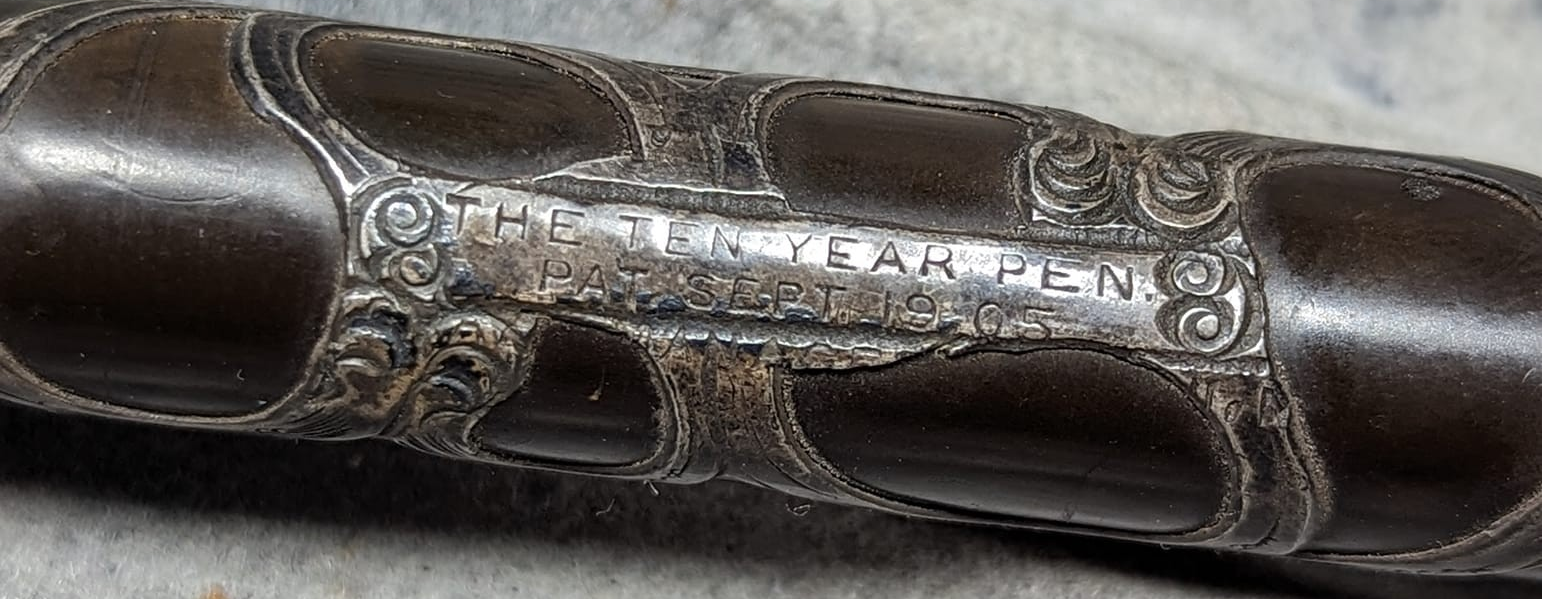For over 35 years Waterman collectors have puzzled over an extraordinarily rare model typically described as a slip-cap safety pen, with an end knob of distinctive form imprinted 1XJ (“X” denoting the nib size). Some have guessed that it was some sort of prototype or experiment. Few have given full consideration to how nonsensical a slip-cap safety pen would be.
Although the J-series pens do not appear in any known Waterman catalog, they are mentioned in both company and retailer advertisements and – most helpfully – in a Canadian instruction sheet that I found several years ago. The “J” stands for “jointless” and while the nib retraction mechanism is the same as that found on early Waterman safeties, the nib is only intended to be retracted for filling. Once the pen is filled the nib is extended and left that way until refilling is necessary.
The first ads that mention Waterman’s Jointless date to the last quarter of 1909. The first that I could find appeared in September with all of the rest appearing in December. Many more followed in the first half of 1910 with only sporadic sightings thereafter. The
last Waterman ad that I could find that mentions the Jointless is in the May 29, 1913
Geyer’s Stationer – though it does get a passing mention in 1915 in a published transcript of a Waterman executive’s
lecture on sales. There it appears only at the tail end of a recounting of miscellaneous models outside of Waterman’s “active line”, suggesting that it was by then out of production but still in inventory or available on demand (
American Stationer, vol. 77, May 22, 1915, p. 30).
 |
| Abraham & Strauss ad, Brooklyn Daily Eagle, 18 Oct 1909, p. 8; perhaps a soft launch – a limited test release – as no further mentions are to be found until regular mentions begin two months later. |
 |
| Bookseller and Stationer (Canada), May 1910, p. 4 |
Ads and instructions only mention three sizes: 12J, 14J, and 15J. Examples of all three sizes are known, all in black hard rubber – though reportedly at least one in red hard rubber is extant. All examples that I have examined have the early internal mechanism with helical grooves cut into the barrel which make the nib carrier twist as it is extended and retracted.
This mechanism was adopted by Waterman for their safety pens in 1908 to avoid infringing Peck & O’Meara’s patent 523,234, then held by the Modern Pen Company (A. A. Waterman), and appears to have been used only until that patent’s expiration in July 1911. Whether Jointless production continued after that date is an open question. Perhaps it did, for our instruction sheet also has a spare parts page where for both safety and jointless models “Interior Spirals” are listed – a term that could in no way be applied to the straight-track equivalents used in their earlier versions.

So what was Waterman thinking? The goal was surely to compete with arch-rival Parker, whose own Jointless had been on the market since c. 1898. Parker’s version required the nib assembly to be pulled out manually from the front of the barrel, a process just as messy as dealing with ink residue at the joint of a conventional dropper-filled pen. Waterman’s version obviated that issue, but at the cost of making the pen as complicated as a safety without the benefits of a safety. And this right at the same time that Waterman brought out its sleeve-filler, a simple design which made filling yet cleaner and more convenient. Perhaps no surprise that the Waterman Jointless was so quickly forgotten.
NOTE: Some extant Jointless pens have unusual protrusions on top of their caps, which in at least some cases are made to be inserted into a matching recess in the turning knob (similar to certain Caw's safety models). I have yet to see any mention or illustration of this feature in contemporary advertisements, however.
NOTE: The Canadian instruction sheet that solved this mystery came into my possession way back in 2008. In 2014 George Kovalenko noted the existence of a short-lived Waterman jointless model in a
blog post but without recognizing the connection with the so-called slip-cap safeties (whose existence but not correct identity was first noted in print as far back as 1987 in Bob Tefft's
Waterman syllabus, with another example shown in Fischler and Schneider's 1994 "Brown Book"). Most of my followup research in digitized periodicals was done in 2017 and the writeup and all photography was done by 2023.


























































